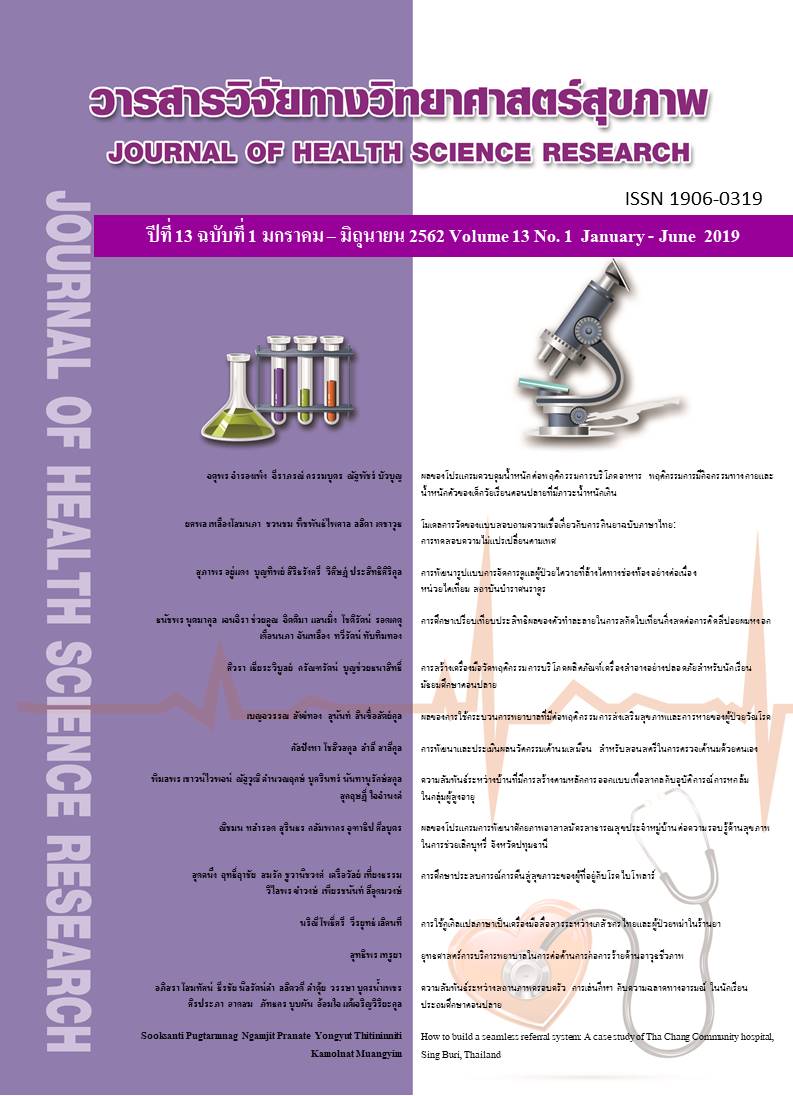การพัฒนารูปแบบการจัดการดูแลผู้ป่วยไตวายที่ล้างไตทางช่องท้องอย่างต่อเนื่อง หน่วยไตเทียม สถาบันบำราศนราดูร
Main Article Content
บทคัดย่อ
การวิจัยเชิงพรรณนานี้มีวัตถุประสงค์เพื่อ 1) วิเคราะห์สภาพการณ์และความคาดหวังของการจัดการดูแลผู้ป่วยไตวายที่ล้างไตทางช่องท้องอย่างต่อเนื่อง 2) สร้างรูปแบบการจัดการดูแลผู้ป่วย และ 3) ประเมินความเหมาะสมของรูปแบบการจัดการดูแลผู้ป่วยกลุ่มตัวอย่าง คือ ผู้ให้บริการ 9 คน และผู้รับบริการ 6 คนเลือกแบบเฉพาะเจาะจงสำหรับวิเคราะห์สภาพการณ์ และความคาดหวัง ผู้ทรงคุณวุฒิ 10 คนสำหรับการประเมินความเหมาะสมของรูปแบบเครื่องมือวิจัยมี 2 ชุดคือ 1) แบบสัมภาษณ์กึ่งโครงสร้าง และ 2) แบบประเมินความเหมาะสมของรูปแบบฯ ตรวจสอบความตรงตามเนื้อหาโดยผู้ทรงคุณวุฒิ 5 ท่าน ได้ค่าดัชนีความตรงตามเนื้อหา เท่ากับ 0.87 วิเคราะห์ข้อมูลด้วยค่าสถิติ ร้อยละและการวิเคราะห์เนื้อหา
ผลการวิจัย พบว่า (1) สภาพการณ์และความคาดหวังของการจัดการดูแลผู้ป่วยพบปัญหา 4 ประการได้แก่ 1) นโยบายและโครงสร้างการให้บริการไม่ชัดเจน 2) การออกแบบและขั้นตอนการให้บริการตามบทบาทหน้าที่ของทีมสุขภาพยังขาดประสิทธิภาพ 3) ผู้ป่วยขาดการมีส่วนร่วมในการรักษาพยาบาลเพื่อการดูแลตนเอง และ 4) ขาดการเชื่อมต่อกับชุมชน และการประสานงานกับหน่วยบริการปฐมภูมิและมีความคาดหวังให้มีการจัดการดูแลผู้ป่วยที่มีประสิทธิภาพยิ่งขึ้น (2) รูปแบบการจัดการดูแลผู้ป่วยที่พัฒนาขึ้น มี 3 องค์ประกอบ ได้แก่ 1) มุ่งเน้นที่ผู้ป่วยและผู้ดูแลเป็นศูนย์กลาง 2) มีนโยบายที่ชัดเจนและความร่วมมือของทีมสุขภาพ และ 3) มีความร่วมมือกับชุมชนและประสานความร่วมมือกับหน่วยบริการปฐมภูมิ และ (3) รูปแบบการจัดการดูแลผู้ป่วยฯ ที่พัฒนามีความเหมาะสมกับบริบทของสถาบันบำราศนราดูรในระดับมากที่สุด (= 4.80, SD=0.40) โดยมีค่าเฉลี่ยต่ำสุด 4.60 และสูงสุด 4.90
Downloads
Article Details
บทความที่ได้รับการตีพิมพ์เป็นลิขสิทธิ์ของวิทยาลัยพยาบาลบรมราชชนนี จังหวัดนนทบุรี
ข้อความที่ปรากฏในบทความแต่ละเรื่องในวารสารวิชาการเล่มนี้เป็นความคิดเห็นส่วนตัวของผู้เขียนแต่ละท่านไม่เกี่ยวข้องกับวิทยาลัยพยาบาลบรมราชชนนี จังหวัดนนทบุรี และคณาจารย์ท่านอื่น ในวิทยาลัยฯ แต่อย่างใด ความรับผิดชอบองค์ประกอบทั้งหมดของบทความแต่ละเรื่องเป็นของผู้เขียนแต่ละท่าน หากมีความผิดพลาดใด ๆ ผู้เขียนแต่ละท่านจะรับผิดชอบบทความของตนเองแต่ผู้เดียว
เอกสารอ้างอิง
2. Chuasuwan A, Praditpornsilpa K, editors. Annual report Thailand renal replacement therapy Year 2014. Bangkok: The Nephrology Society of Thailand; 2014. (in Thai).
3. Bureau of Epidemiology, Department of Disease Control, Ministry of Public Health. Kidney disease threats around them [Internet]. 2017 [cited 2017 Jul 7]; Available from: http://203.157.15.110/ boe/viewddcw.php. (in Thai).
4. Artiwitchayanon A, Keeratiyutawong P, Duangpaeng S. Predictors of self-management in patients with chronic kidney disease undergoing continuous ambulatory peritoneal dialysis [Non-Publish]. Chonburi: Faculty of Nursing, Burapha University; 2015.(in Thai).
5. Wagner EH, Austin BT, Davis C, Hinmarsh M, Schaefer J, Bonomi A. Improving chronic illness care: Translating evidence into action. Health Aff (Millwood). 2001;20(6):64-78.
6. Buno-pash M, Nilphat T. The development of a caring model for patients with end-stage renal disease on continuous ambulatory peritoneal dialysis by registered nurses in region 11, shealth care network. Region 11 Medical Journal. 2015;29(1):1-11. (in Thai).
7. Setboonsrang K, Prasomrak P. The care model development for end stage renal disease patient who had renal replacement therapy on self-care and quality of life in Loengnoktha Crown Prince Hospital, Yasothon Province. Community Health Development Quarterly Khon Khan University. 2016;4(4):485-503. (in Thai).
8. Ukati K, Chantajirakhovit N. Self-care agency and quality of life in end stage renal disease patients undergoing continuous ambulatory peritoneal dialysis. Songklanagarind Medical Journal. 2007;25(3):171-7. (in Thai).
9. Hanmontree T, Moolsart S. Service quality based on patient-centered care as perceived by professional nurses at community hospitals under Ministry of Public Health, the Inspection Region 1. Thai Journal of Nursing. 2014; 63 (4):49-56. (in Thai).
10. Petchroung N, Priyatruk P, Thongkeang V. The study of continuing care for patients with cerebrovascular disease in primary care unit. Journal of The Royal Thai Army Nurses. 2013;14(1):25-34. (in Thai).
11. Annapanurak R, Manit A. Development of nursing service system among chronic kidney disease patients receiving continuous ambulatory peritoneal dialysis by using case management concept at King Narai Hospital, Lop Buri. Thai Journal of Cardio-Thoracic Nursing. 2015;26(1):133-84. (in Thai).
12. National Health Security Office. National health security fund management manual. Bangkok: Moonlight Publishing; 2009. (in Thai).
13. Cherngyooth K, Oba N, Laksomya T. Caring outcomes of patients with type 2 diabetes by contracting unit of primary care, Naresuan University Hospital. Journal of Nursing and Health Sciences. 2012;6(2):110-21. (in Thai).
14. Uengtrakul S, Tangpukdee S, Kaewmafai J. Development care services model for patients with end stage renal disease who received the continuous ambulatory peritoneal dialysis at Roi-Et Hospital. Journal of Nursing and Health Care. 2014;32(4):49-59. (in Thai).
15. BernsteinSJ. A new model for chronic care delivery. Front Health Serv Manage. 2008;25(2):31-8.
16. Tantivichitvej R. A development of peritoneal dialysis with community networks at Photharam District, Ratchaburi Province [Dissertation]. Bangkok: Mahidol University; 2015. (in Thai).
17. Phinyo P, Phinyo K, Limtragool P, Tiamkao S, Worawong C, Chuasuan W, et al. Care improvement for patients with stroke through community participation. Songklanagarind Journal of Nursing. 2015;35(2):93-111. (in Thai).


